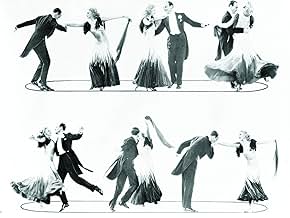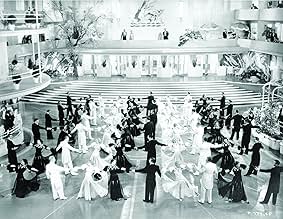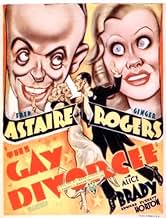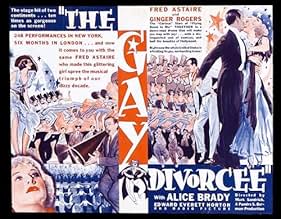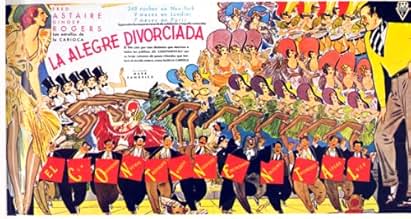Une jeune femme souhaitant divorcer simule un adultère en engageant par correspondance un homme qui se fera passer pour son amant. Elle rencontre à la douane Guy Holden, un danseur, et est p... Tout lireUne jeune femme souhaitant divorcer simule un adultère en engageant par correspondance un homme qui se fera passer pour son amant. Elle rencontre à la douane Guy Holden, un danseur, et est persuadée qu'il s'agit de son homme de paille.Une jeune femme souhaitant divorcer simule un adultère en engageant par correspondance un homme qui se fera passer pour son amant. Elle rencontre à la douane Guy Holden, un danseur, et est persuadée qu'il s'agit de son homme de paille.
- Réalisation
- Scénario
- Casting principal
- Récompensé par 1 Oscar
- 4 victoires et 5 nominations au total
- Undetermined Role
- (non crédité)
- Undetermined Role
- (non crédité)
- Undetermined Role
- (non crédité)
- Dancer
- (non crédité)
- Chorus Girl
- (non crédité)
- Dancer
- (non crédité)
- Night Club Patron
- (non crédité)
Avis à la une
Mark Sandrich worked with Ms. Rogers and Mr. Astaire in several movies. Somehow, "The Gay Divorcée" is one of their best collaboration. This film is a lot of fun to watch, even after more than 70 years after it was made. It speaks volumes for all the people involved in the production of this movie.
The Great Depression was the right background when movies like this were made. In a way, it was an escape from the harsh realities of the times America was going through. The public went to the movies to see their favorite stars that were shown in such a glamorous roles. How could anyone not admire the great Fred Astaire, always impeccably dressed? Or how could not any woman in the theater envy Ms. Rogers's beauty and easy grace? That era made it right for Hollywood to show the world a sensitivity and sophistication that only few rich types were able to enjoy in real life, while the rest was trying to eke out a life of whatever work they could find.
The musical numbers are amazing. "The Continental" alone, must have blown the budget of the picture. Imagine how much it would cost today to have all those dancers in a sound stage! Not only that, but in that lengthy number, there are at least four changes of costumes for the women. Also, he is delightful singing "Looking for a Needle in a Haystack". A young and radiant Betty Grable makes an appearance singing "Let's K-knock K-knees" in which she shows a bit of her enormous charm and talent.
Ginger Rogers makes a gorgeous Mimmi Glassop. Alice Brady, is perfect as the dizzy Aunt Hortense. Edward Everett Horton plays an excellent Egbert Fitzgerald, the divorce lawyer. Erik Rhodes is one of the best things in the film; his Signor Tonetti injects a funny shot into the movie. Eric Blore, as the waiter, has great moments in the movie.
In setting the film in London and Brighton, a rich texture is added to this winning picture that will remain a favorite that will live forever because of the chemistry that Ginger Rogers and Fred Astaire produced in anything they did together.
The plot is suitably - and delightfully - trivial. Musical star Guy Holden (Fred) happens upon a girl (Ginger), falls desperately in love with her, then spends the rest of the picture trying to free himself from marvellously silly plot threads and Everett Horton's exquisite quadruple-takes.
Keeping just one song from Cole Porter's original score, the timeless 'Night and Day', and adding only four others, The Gay Divorcée is more a comedy with songs than it is a musical comedy. But what comedy - and what songs! 'Looking For a Needle in a Haystack' is a masterpiece of economy: Fred a whirlwind of frustrated, lovestruck energy as he spins around his hotel room lamenting his missing love in peerless style. "Men don't pine," he memorably concludes, "Women pine. Men ... suffer." Everett Horton's rare excursion into song-and-dance territory is a breath of hysterical, liberating ludicrousness, as he knocks knees with a young Betty Grable. 'Don't Let It Bother You', performed by a chorus of dancing girls (and dolls), then spectacularly reprised by a tapping Astaire, is another treat. 'The Continental', the film's vast production number is peculiarly edited but sporadically fine and offers a fitting climax.
It's exceptional fluff, the sort of heady, heightened escapism that you don't come close to very often. An extravagantly mounted, joyous comedy played to perfection by two stars at their irresistible peak. Unmissable.
In 1933, the pair had proven themselves as second leads in "Flying Down to Rio", a musical heavily relying on special effects and little else. They stole the show, proven with "The Carioca", the erotically charged dance number which started an American craze of pressing foreheads and even got the Best Song Oscar nod over the supposed show stopping title song. Before, Ginger had "42nd Street" to her name, while Fred had the famous screen test analysis of "Can't sing. Can't act. Can dance a little."
"The Gay Divorcee" is the establishing musical of Astaire and Rogers. Silly, dated, slight, even stupid to a certain degree is the entire story. Without a doubt, high comedy and immense creativity make up for it. The mistaken identity plot was recycled for "Top Hat" the following year, but it hardly matters. It is littered entirely with hilarity! Writing was never the strongest point of these musicals anyway. The performances were not Oscar calibre but they were publicly loved, and it's obviously Astaire and Roger's singing, acting and most of all, dancing, that makes the movie what it is.
A top wealth of talent was assembled for the movie. Erik Rhodes is absolutely side splitting as the Italian guy Tonetti, wielding the fabulous line, "Your wife is safe with Tonetti, he prefers spaghetti!". Alice Brady is there as Aunt Hortense, but Edward Everett Horton is another stand out performer as the lawyer. His fumbling voice provides a character of clumsiness and two seem to go hand in hand. He was definitely one of the best supporting comedians of the 1930s and 1940s, in other Astaire and Rogers musicals, and movies like "Lost Horizon", "Holiday", "Here Comes Mr Jordan" and "Arsenic and Old Lace".
Only one song was retained for the filmic version of "The Gay Divorcee". The censors even crashed down on the stage's original title "The Gay Divorce". Fred performs a great rendition of the immortal Cole Porter song "Night and Day". "The Continental", the Best Song of 1934 is thrown there in the mix too. Other great numbers in there include "Looking for a needle in a haystack", "Don't Let it Bother You" and "Let's K-nock- K-nees". The latter is performed by a young Betty Grable. This is notable for the only time Edward Everett Horton sings and dances on screen. We can see from the results there's an obvious reason.
The stylish period of courtship and even set decoration and costumes evoke great memories of eras gone by. RKO hasn't helped preservation of these technical elements by throwing what always appears to be mediocre sets, but it doesn't matter anyway. The whole thing is irresistible, spectacular and unforgettable. This is one of the forgotten musicals of the time which has it all.
Rating: 8/10
With few exceptions, the plots of the Fred-Ginger films were excuses to get to the important part - the dancing - but the story lines were always pleasant and the casting good.
"The Gay Divorcée" was based on a Broadway musical (of which the only number retained is "Night and Day") and it appears that a few of its plot devices were adopted in later Astaire-Rogers films as well.
One such plot device is that of mistaken identity. In this movie, Astaire (reprising his Broadway role) is mistaken for a professional correspondent hired to help Rogers get her divorce. Another device is that at first, Ginger is never interested in Fred - that goes here, too.
And there's a stock cast in these films, namely, Edward Everett Horton and Eric Blore (and of course, he's always the butler and always very funny). Horton plays Rogers' attorney whose major problem is Rogers' aunt (Alice Brady).
What can be said about the dancing except that it's glorious? Fred and Ginger dance to "Night and Day" after Astaire sings it to her. For a supposed non-singer, Astaire could really put over a song - his voice is pleasant and he's so musical - no wonder composers wrote songs for him.
Ginger is beautiful and spunky as Mimi, a young woman ducking Fred while she's trying to get a divorce. Betty Grable has a bit that showcases her in the number "Let's K-knock Kneez." There's also "I'm Looking for a Needle in a Haystack" delightfully sung and danced by Fred. Astaire's dancing is fantastic throughout.
It feels as if about half the picture is taken up with the elaborately staged production number, "The Continental." In later films, of course, the dancing would center more around Fred and Ginger, but it's a great part of the movie and certainly solidified these two as a top box office pairing.
For pure enjoyment, there's nothing like watching Astaire & Rogers in these movies.
Le saviez-vous
- AnecdotesThe musical number "The Continental" lasts 17 1/2 minutes, the longest number ever in a musical until Gene Kelly's 18 1/2-minute ballet at the end of Un Américain à Paris (1951) 17 years later. It is also the longest musical number in all of Fred Astaire and Ginger Rogers' films together.
- GaffesDuring the car chase, Guy makes a quick turn on a dirt road, and a sound effect of squealing tires is heard. Tires do not make a squealing noise on dirt.
- Citations
Tonetti: [unable to remember his passphrase "Chance is a fool's name for fate," Tonettie repeatedly muffs it] Chance is the foolish name for fate. / Give me a name for chance and I am a fool. / Fate is a foolish thing to take chances with. / I am a fate to take foolish chances with. / Chances are that fate is foolish. / Fate is the foolish thing. Take a chance.
- Versions alternativesIn the version of the movie released in Brazil in the 1930s, the Brazilian actor Raul Roulien sang in the musical number "The Continental".
- ConnexionsEdited into Jeanne de Paris (1942)
- Bandes originalesDon't Let It Bother You
(1934)
Music and Lyrics by Mack Gordon and Harry Revel
Dance performed by Fred Astaire
Meilleurs choix
- How long is The Gay Divorcee?Alimenté par Alexa
Détails
- Date de sortie
- Pays d’origine
- Site officiel
- Langues
- Aussi connu sous le nom de
- La alegre divorciada
- Lieux de tournage
- Santa Monica, Californie, États-Unis(Exterior)
- Société de production
- Voir plus de crédits d'entreprise sur IMDbPro
Box-office
- Budget
- 520 000 $US (estimé)
- Montant brut mondial
- 6 879 $US
- Durée1 heure 47 minutes
- Couleur
- Rapport de forme
- 1.37 : 1
Contribuer à cette page




